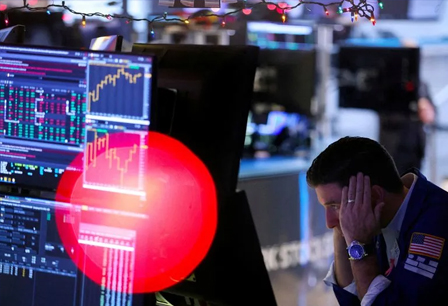A key US inflation gauge increased last month at its fastest pace since April 2023, showing that underlying price pressures remain persistent.
The Producer Price Index, a closely watched measure of inflation at the wholesale level, rose 2.1% for the 12 months ended in March, up from a 1.6% gain in February, according to Bureau of Labor Statistics data released Thursday.
While the increase was below expectations — FactSet consensus estimates had the annual increase at 2.3% — the acceleration in the prices producers pay for goods and services highlights the persistence of inflation, the bumpy path to bring it lower, and supports fears that interest rates will stay higher for longer.
PPI captures average price shifts before they reach consumers and serves as a potential signal for the prices consumers ultimately end up paying.
“Producer prices were flat to falling throughout 2023; all three months of 2024 have seen a resumed upward trend,” Kurt Rankin, senior economist with PNC Financial Services Group, told CNN in an interview. “We’ve got plenty of upward pressure from the supply side of the economy still to make its way through to consumers over the coming months; and, of course consumer demand has not waned.”
“The inflation fight is still very much on,” he added.
Adding to that concern, the monthly gain in wholesale inflation wasn’t because of rising gas prices.
On a monthly basis, US wholesale prices rose 0.2%, which was markedly slower than the 0.6% gain in February. Driving the monthly gain was a 0.3% rise in services prices, according to the BLS.
Producers’ prices for goods fell 0.1%, a decline attributed to energy prices falling 1.6% for the month, moderating from February’s 4.1% monthly increase. However, considering that oil and fuel prices remain on the rise, that component could add further pressure on wholesale prices in months to come, Rankin said.
“We’ve now got oil prices that are not fully reflected in the March report that producers will be facing, and that’s going to put some upward pressure,” Rankin said.
When stripping out the more volatile components of food and energy, the closely watched “core” index moved higher for the third consecutive month, rising to 2.4% annually, up from 2.1% the month before. On a monthly basis, the core PPI slowed in line with expectations to 0.2% from 0.3%.
Economists had projected that core PPI would rise 2.3% annually.
Despite the increases, the annual rate of wholesale inflation (on both the overall and core level) is rising in line with what was seen in the years before the pandemic.
However, the acceleration comes at a bad time: Wednesday’s hotter-than-expected Consumer Price Index stoked concerns that both inflation and interest rates will remain higher for longer.
“It is difficult to know what the proper course for the Fed’s interest rate policy is right now but, certainly, the need to restart its rate hikes, paused since last July, does not seem to be necessary at this juncture,” Chris Rupkey, chief economist at FwdBonds, wrote Thursday.
The goods and services pricing dynamics in Thursday’s PPI is playing out at businesses like All Pets Considered, an independently run pet supplies retailer that got its start more than 30 years ago and now has two locations in Greensboro, North Carolina.
The US pet products industry experienced record inflation in recent years, with prices for food and accessories far outpacing overall inflation. The soaring price hikes came in the wake of a pandemic where more Americans added pets to their families.
“I think the pricing and inflation has stabilized after really drastically going up in ’22 and some of ’23,” Alison R.H. Schwartz, All Pets Considered’s co-owner and general manager, told CNN in an interview. “Doesn’t mean we’re not still seeing price increases; but it’s not like they were in ’22, where it was just hand over fist that we were having two and three increases from different brands.”
In recent months, some of those prices have even started to fall, she said.
But on the services side of the business, it’s a little bit of a different story. The demand for grooming services exceeds the supply of available workers, she said.
“That section of the business hasn’t seen the ebbs and flows like the retail sector and is still a pretty constantly active business that doesn’t seem to have slowed at all,” she said. “We have had to raise prices and probably will again later this year or early next year, just to keep up with inflation and to keep in mind the cost of living and everything for our employees.”
Through the first quarter of this year, inflation data has showed that the pace of price hikes remain stubbornly high. It also reiterates what Federal Reserve officials, especially Chair Jerome Powell, have been saying all along: The fight to rein in high inflation and bring it down to target (2% annual rate as measured by the Personal Consumption Expenditures price index) will be a long and bumpy process.
Inflation has slowed dramatically from the 40-year highs hit in 2022. In that time, the US central bank executed a series of large rate hikes before going into standby mode during the past several months.
Despite the “last mile” living up to its arduous expectations, the Fed still has a potential soft landing, where inflation is tamped down without a surge in unemployment, in its sights: The labor market didn’t buckle under the crushing weight of rapidly higher interest rates; instead, it remained historically strong.
In March, the US economy added 303,000 jobs, the unemployment rate remained below 4%, and wage growth eased closer to historic norms.
On Thursday, separate data from the Department of Labor showed that layoff activity remains muted. First-time claims for unemployment benefits, considered a proxy for layoffs, totaled 211,000 for the week ended April 6, down 11,000 from the prior week’s upwardly revised level.
Economists were expecting that Americans would file 216,500 initial claims.
“A soft landing is still achievable,” Rankin said. “The economy is based on the US consumer and workers bringing home a paycheck and spending that paycheck: That’s 70% of the economy. We’re still creating jobs above expectations month after month, wage growth is still above consumer price inflation.”
As such, the Fed can bide its time for a few more months, he said.
Markets and economists have reined in their rate-cut expectations — some going as far as taking cuts off the table — amid the hotter-than-expected data. PNC is still forecasting that the Fed will make three quarter-point rate cuts this year, with the first to come in June.
“There’s enough growth in the US economy now that rate cuts are not needed to further juice the economy to incentivize growth,” Rankin said.












